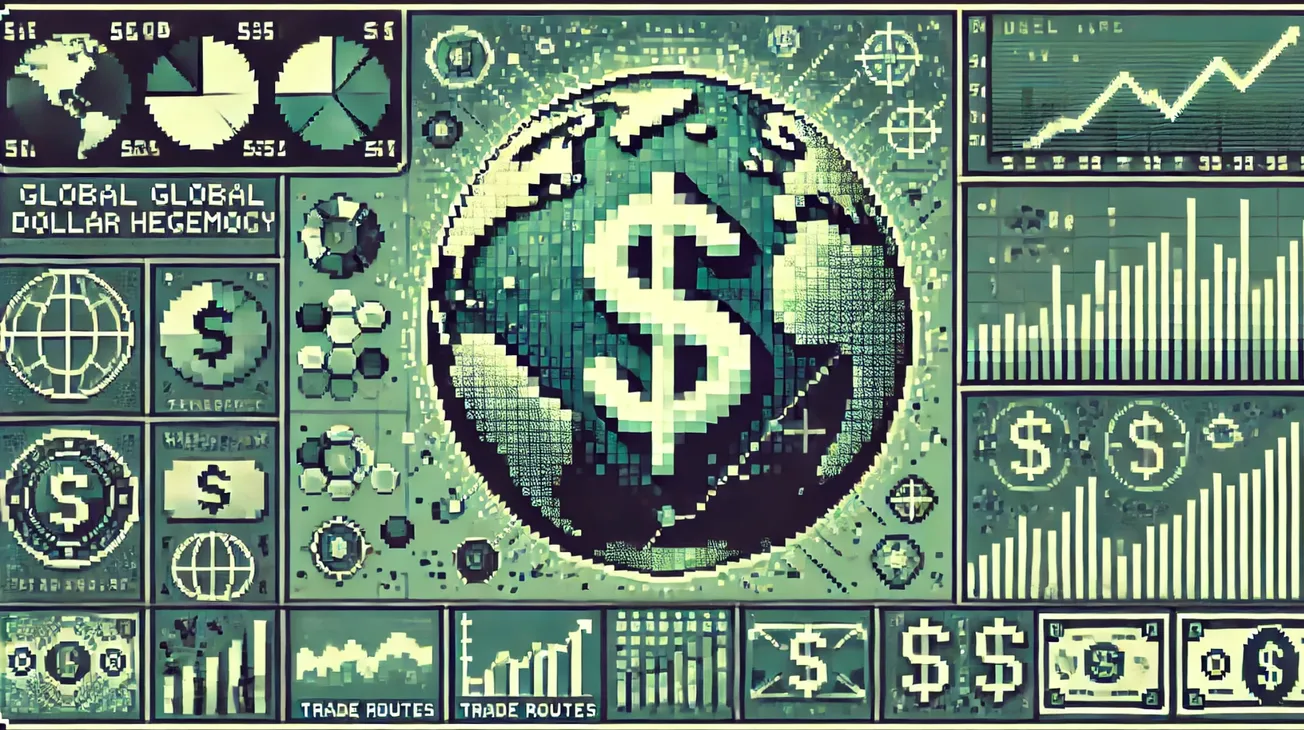Table of Contents
Britain’s budget deficit: 4.7% of GDP. France’s deficit: 5.5% of GDP. America’s deficit: 6.5% of GDP.
France and Britain face debt crisis: emergency budgets, automatic austerity, and political turmoil. Yet as they slide into bankruptcy, America happily hikes spending and cuts taxes, as if debt is costless.
This is because America has a magic power keeping the gods of debt at bay: dollar hegemony. Built over a century of American economic and military dominance, dollar hegemony—the dollar’s unique role as the world’s reserve currency and the foundation of global finance—allows us to sustain staggering deficits at low cost. The world’s demand for dollars ensures that the US can run deficits that would sink any other country, while offloading their inflationary impacts onto our economic partners.
But dollar hegemony is neither automatic nor limitless. A mix of international involvement and fiscal and regulatory restraint has long underpinned the dollar’s dominance. Blind to this reality, America is killing our golden goose through fiscal recklessness and strategic neglect.
And so, France and Britain offer America two unpopular lessons. The obvious: debt carries consequences. The hidden: we cannot afford isolationism.
***
Empires used to be obvious: maps marked in red, purple togas, or gunboats in foreign harbors. They ruled through fear and force, openly exploiting the victims for the victors’ benefit. As humanity matured, empires shifted from spheres of violence to spheres of economic power which, in appearance and in fact, were more mutually beneficial to conquered and conqueror than previous arrangements.
Modern America is so sophisticated as to lack any traditional empire at all: no colonies and no tribute. Unsurprisingly, many Americans question the benefits of our active involvement in global affairs.
Indeed, at face value, it isn’t clear how we extract advantages from our hegemony. We spend trillions of dollars on our military, diplomacy, foreign aid, and foreign investment, enriching the world by guaranteeing its security, transferring technology, and showering it with investment, without direct recompense, while other countries - including our putative European allies - often treat the US with considerable and unwarranted scorn.
The answer is dollar hegemony, meaning the dominance of the US dollar, which covertly siphons trillions from the global economy to the US each year, and which enables our exponentially-growing debt binge while dampening its inflationary side effects.
Across the global economy, the dollar reigns supreme. As of 2022, 59% of global foreign currency reserves, 64% of world debt, 58% of non-EU international payments, and 54% of foreign trade invoices are in dollars. The US dollar contains more economic activity than all other currencies combined, though the US produces only a quarter of global GDP. These statistics, having remained mostly unchanged since 1989, reflect dollar dominance durable, though perhaps faltering; the dollar remains the go-to, trustworthy currency.
The benefits, rarely acknowledged in political discourse, are immense. Primarily, dollar hegemony lets us borrow gargantuan quantities of debt at low interest rates. Because the dollar is convenient and reliable, dollar assets, including US debt, are agreed-upon as safe, even “risk-free”.
Consequently, foreign investors, especially large institutions in the developing world, will park as much money in dollars as they can, ensuring the US doesn’t run out of money to borrow. Ironically, despite the US government having printed trillions of dollars since COVID, the limiting factor in this transaction remains the supply of dollars, not the demand. This is why we’ve been able to increase our debt exponentially, with no end in sight, while nations like France and Britain, though far less indebted, are making fiscal policy at the end of an insolvency gun. Effectively, dollar hegemony lets the US siphon trillions of foreign capital as debt, never to be repaid.
Expectedly and unfortunately, America has grown addicted to debt. Free debt underpins American prosperity: each year, we inject trillions of dollars of essentially free money into our economy, funding things as essential as healthcare, technological investment, and government corruption.
Meanwhile, dollar hegemony outsources the consequences of our fiscal irresponsibility. Debt begets inflation, but inflation, after all, devalues all dollars equally, and so is spread out across the world. In other words, the rest of the world—which owns the majority of dollars—is forced to eat most of the inflation from our deficit spending.
So when President Biden’s administration claimed success in fighting inflation because inflation rates are higher in the rest of the world, know that it’s a lie. Of course everyone else will experience higher inflation, because they suffer both our deficit-fueled inflation and their own.
***
History shows there are two ways dollar hegemony can end.
One is isolationism and weakness abroad. Ultimately, as all empires do, dollar hegemony rests on a foundation of force, of American strength overseas. Partially, this is because America grants political protection to some allies in exchange for buttressing the dollar; for example, Saudi Arabia sells its oil overwhelmingly in dollars in exchange for American military protection.
More broadly, financial dominance follows political dominance. Across history, whenever empires gain political hegemony, their currencies gain economic hegemony too - be it the Roman denarius, Dutch guilder, or British pound; conversely, as soon as empires lose their dominance, their currency diminishes also. For instance, Dutch interest rates finally soared above British rates only when Napoleon decisively defeated and overrun the Netherlands, marking the final death of Dutch hegemony.
Yet empires do not always fall by conquest. The other path to dollar collapse is financial self-sabotage. A nation can lose its currency’s supremacy simply by drowning in debt. The US dollar began supplanting the British pound as the world’s premier currency after World War I, not because Britain lost the war, but because it left the war bankrupt. Britain’s gargantuan war debts hollowed out its financial strength, causing investors to lose confidence in a self-fulfilling prophecy of financial decline.
Currency hegemonies are like steel springs—immensely strong, but not unbreakable. Dollar hegemony has stretched enormously to absorb extraordinary, far more than many anticipated. But when pulled too far—when deficits spiral unchecked—it will snap. And when it does, the modern economic order, built around it, will recoil violently.
Unfortunately, we are straining both these fault lines at once. Our thoughtless deficit spending only compounds a foreign policy deeply neglectful of dollar hegemony. For one, we unacceptably tolerate economic subversion from our notional allies. For years, the EU has worked to undercut the dollar in the euro’s favor, pushing for euro-denominated international trade, euro-denominated international assets, and euro-backed alternatives to SWIFT, the world’s dollar-based processing system for financial transactions. Where preserving the dollar should be a key national priority, we instead turn a blind eye. Worse still, by projecting weakness, successive US administrations have invited aggression from regimes like Iran, Venezuela, and Russia, forcing us to overrely on sanctions to contain emboldened enemies, where we should have used deterrence.
Consequently, signs of the dollar faltering have begun to spring up. The share of financial assets stored in dollars (i.e., dollar-denominated securities), has plummeted from 71% in 1999 to 58% in 2022. In the past two years, the Russia-Ukraine war has further accelerated this shift away from the dollar. Despite having weeks of advance notice that Russia would invade Ukraine, the Biden administration did nothing to project military force in the region or otherwise deter the invasion. Instead, the US and our Western allies have cut Russian banks out of SWIFT, using dollar hegemony to isolate Russia from the global financial system.
Desirous of Russian oil, and fearful of suffering a similar fate, much of the world has responded by shifting to non-dollar currencies. For example, the BRICS countries (an intergovernmental organization consisting of Brazil, Russia, India, and China, among others) have considered creating a rival network to SWIFT that transacts in their local currencies. Sino-Russian trade has shifted to yuan, with “nearly all of its purchases of oil, coal and some metals from its neighbour now settled in the Chinese currency instead of dollars” per Reuters.
All signs point to a world in which the dollar may not reign supreme.
For America, the consequences would be devastating. A world without dollar hegemony, and the limitless free debt it entails, is a world where the US looks a lot like France and Britain tomorrow: poorer than Mississippi, compelled to sell off city parks to make ends meet, sliding into bankruptcy merely to afford existing pension obligations, let alone military force or technological innovation.
***
We can still defend dollar hegemony.
Traditionally, disciplined fiscal policy, strategic trade agreements, and monetary diplomacy have reinforced dollar dominance. Strengthening these pillars can slow decline. However, the current environment presents challenges: rising US debt, shifting Treasury demand toward more price-sensitive investors, and foreign reserve diversification away from the dollar all threaten its global standing. The Treasury Borrowing Advisory Committee (TBAC) has noted that while demand for US debt remains strong, it is increasingly reliant on mutual funds, pension funds, and domestic investors, with banks and foreign governments reducing their holdings. This shift increases borrowing costs and exposes the US to greater financial volatility.
To maintain the dollar’s status, policymakers must curb fiscal recklessness, ensure US capital markets remain the most attractive globally, and forge deeper trade and financial ties with allies to reinforce the dollar’s role in global reserves and transactions. Without intervention, alternatives such as China's yuan or regional currency blocs could gain traction, accelerating the erosion of American financial influence.
In a digital age, other methods exist to increase demand for American treasuries, namely stablecoins. Stablecoins are digital assets pegged to fiat currencies, the most popular of which is the dollar, and which are backed by reserves of US dollars and government bonds. The stablecoin ecosystem is now the 18th largest holder of US Treasuries, making them the 18th largest holder of American debt, surpassing nations such as Germany and the Netherlands. As stablecoins become a more popular method to store and exchange value, particularly in inflation-riddled nations, their need for US treasuries will skyrocket, offering a potential solution to faltering dollar hegemony. So promising is this approach that former Speaker of the House Paul Ryan wrote an opinion piece in the Wall Street Journal supporting their utility. Ryan writes that “stablecoins are analogous to the offshore dollar-denominated liabilities that turbocharged dollar pre-eminence during the Cold War.” This innovation, combined with sensible policy, may offer a way to bolster the dollar far into the future.
Declining dollar hegemony is an existential risk to our way of life, which relies on money freely available to maintain millions of people on welfare and inflate our living standards. A failed treasury auction, the clearest symbol of demand for dollars globally, is a sure sign of the death of the American empire, and cannot be allowed to occur. Without trillions of almost free money each year, perhaps the US economy will prove to be less than exceptional.





